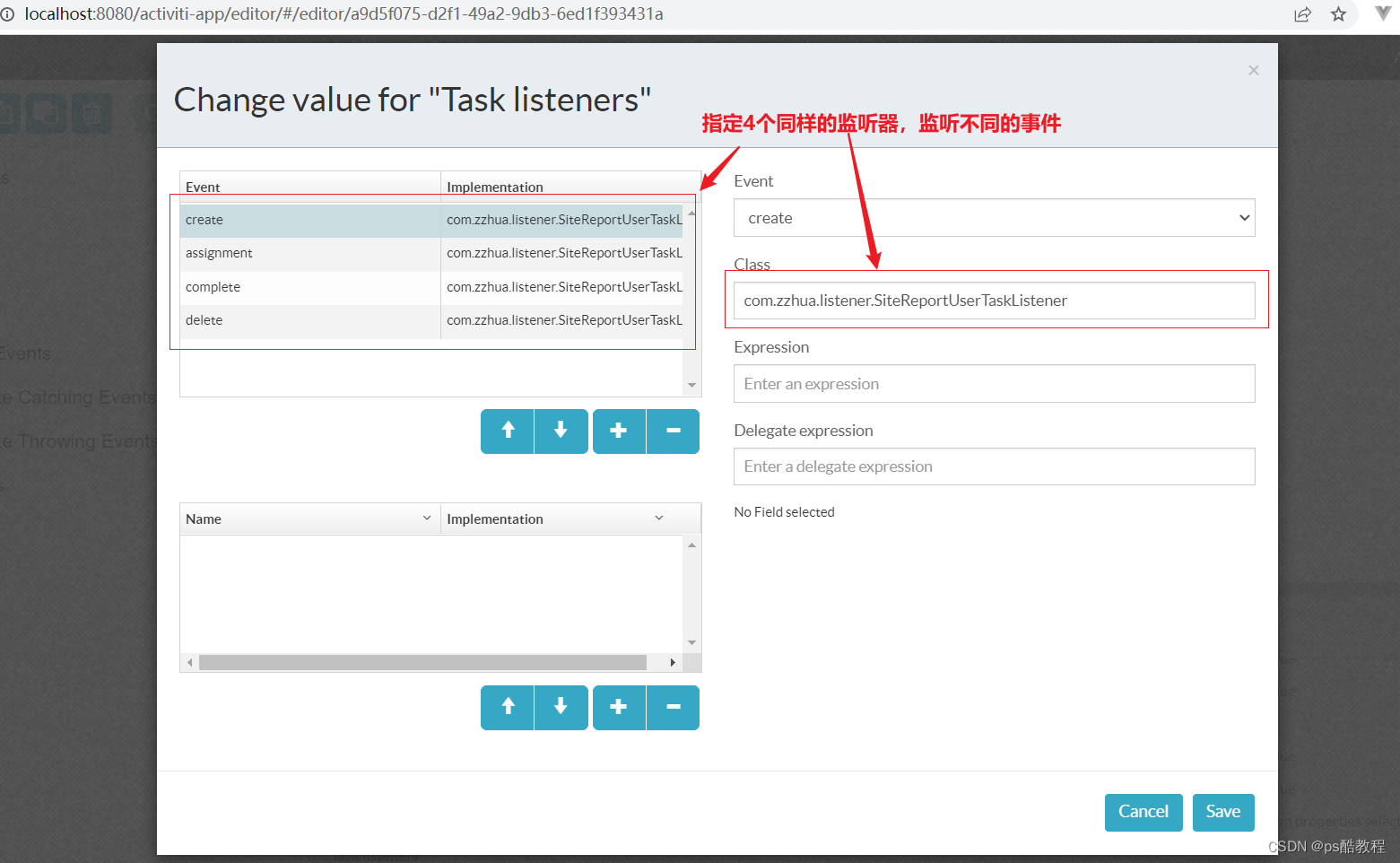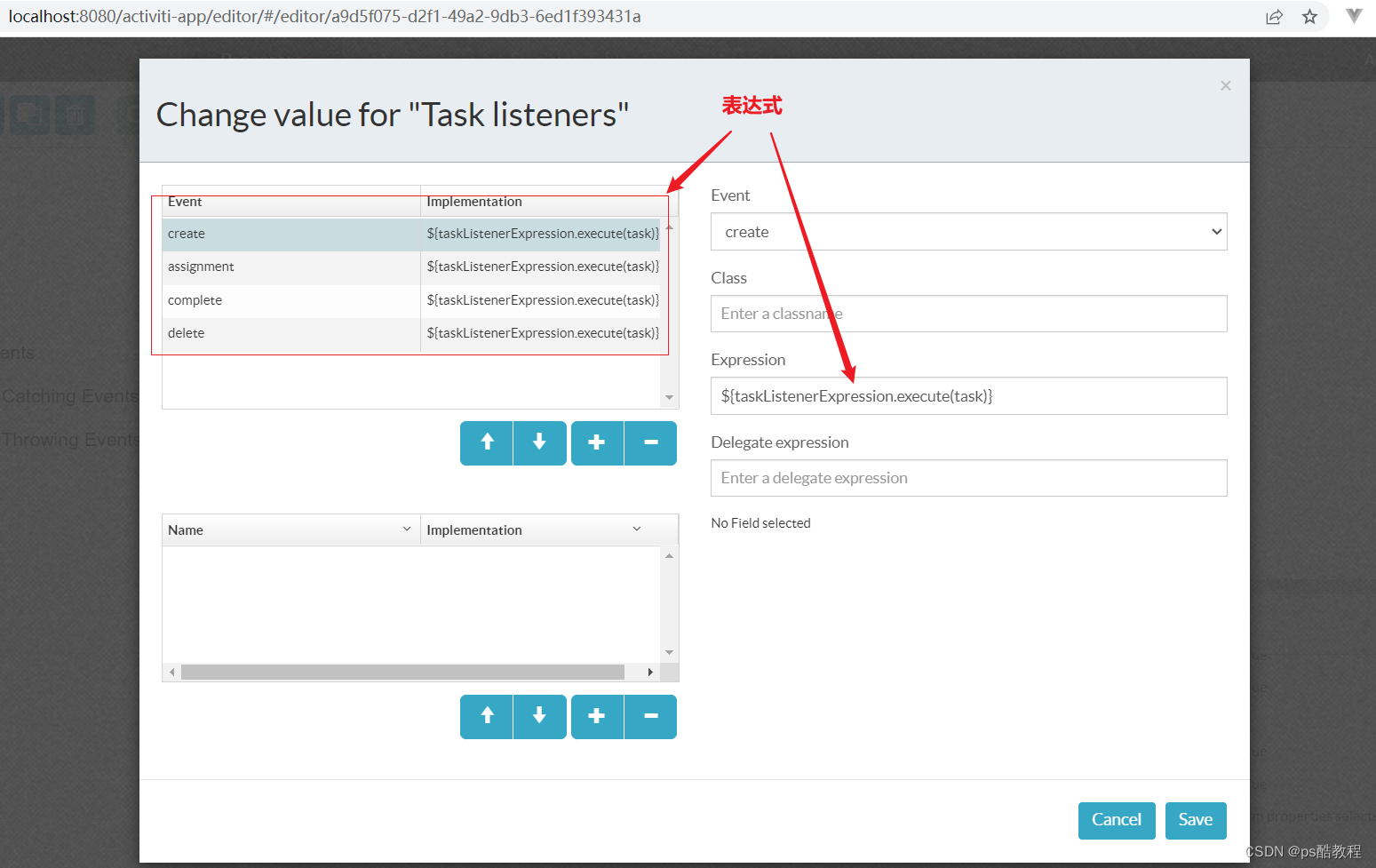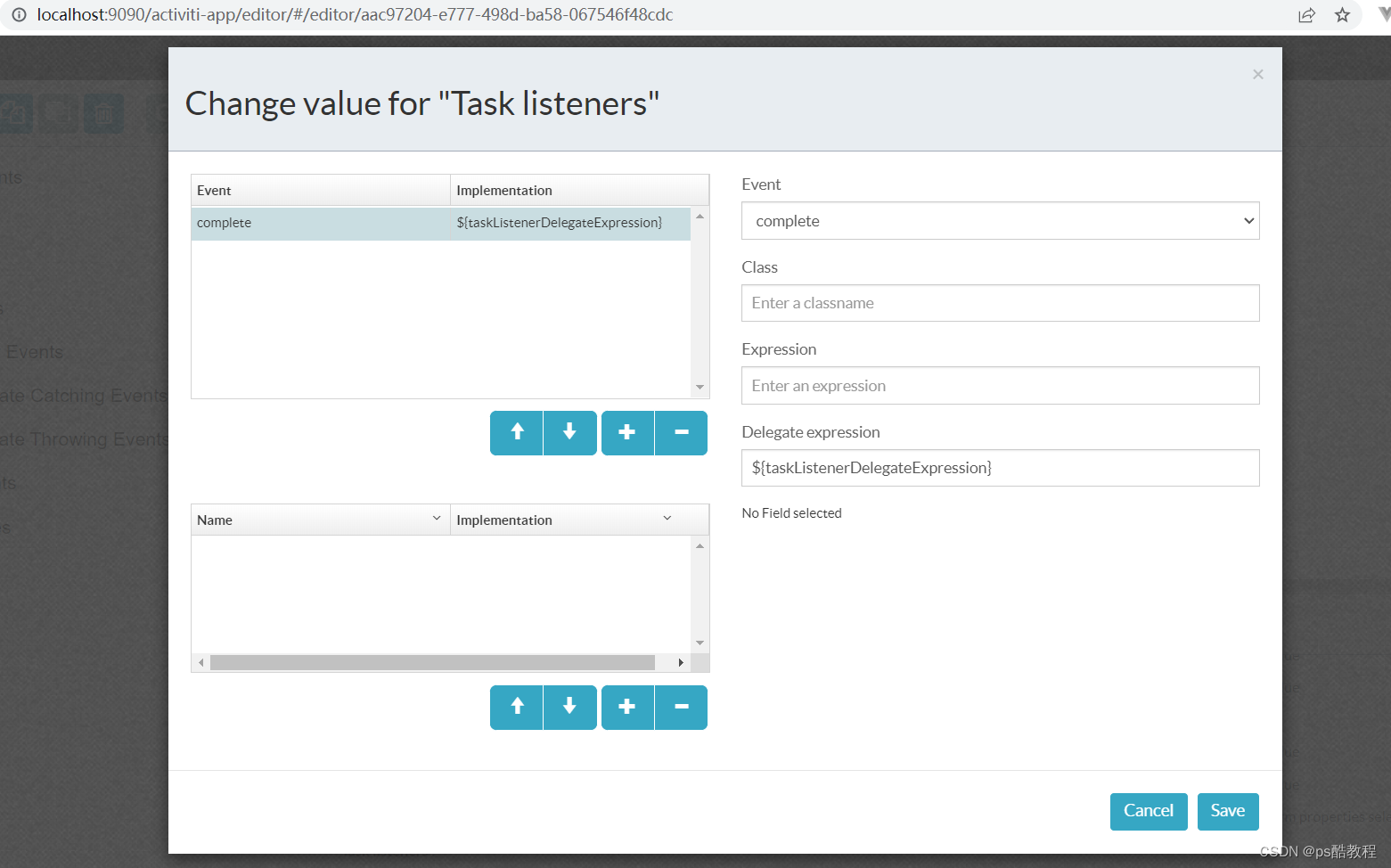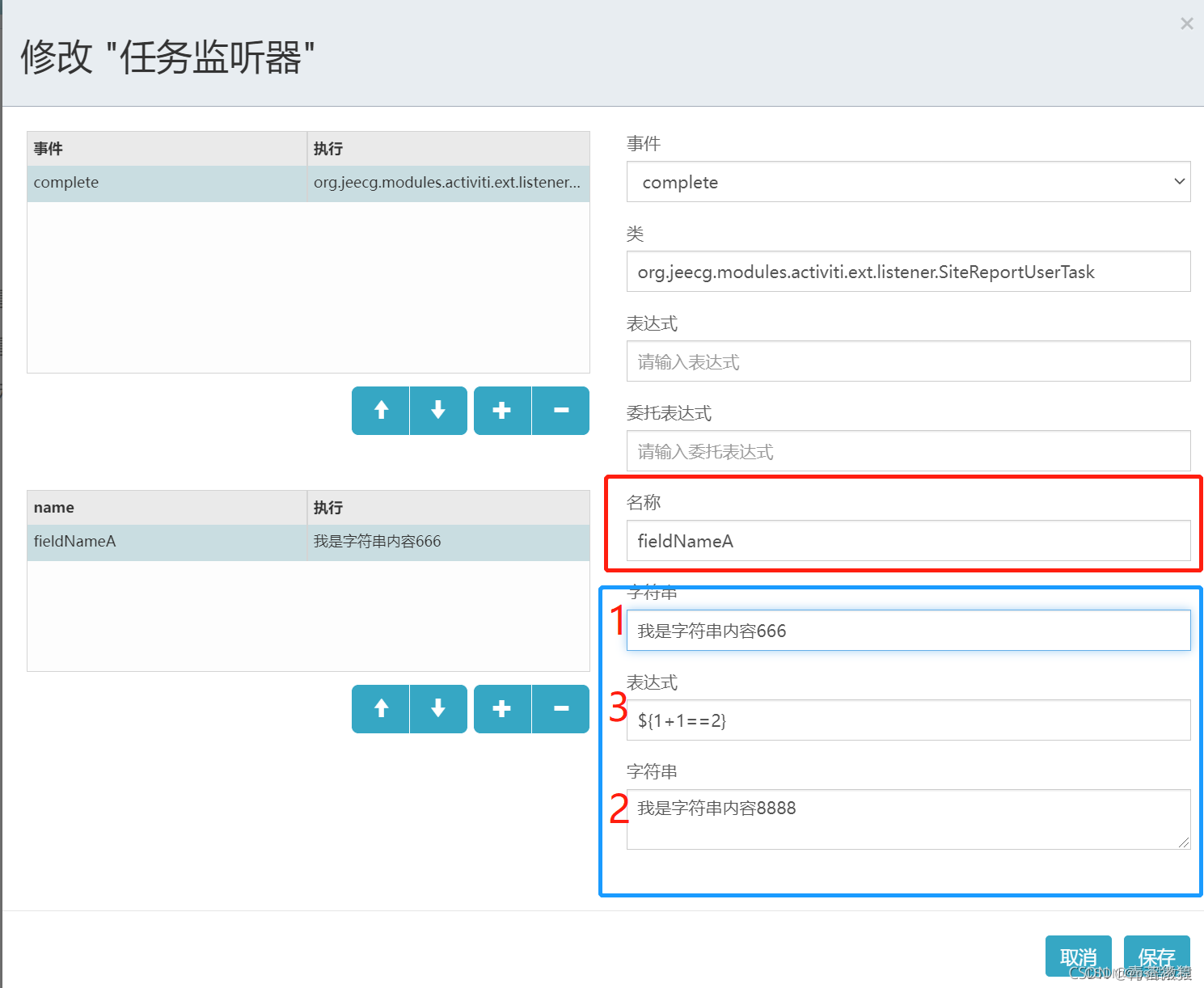文章目录
- 学习链接
- 任务监听器 TaskListener
- 监听的事件
- TaskListener 接口
- 监听器委托类DelegateTask
- 任务监听实现方式 — 类class
- 绘制流程图
- 自定义任务监听器
- SiteReportUserTaskListener
- 测试
- 监听实现方式 — 表达式expression
- 绘制流程图
- 自定义 TaskListenerExpression
- 测试
- spring表达式
- 监听器实现方式——委托表达式delegateExpression
- 绘制流程图
- 自定义 TaskListenerDelegateExpression
- 测试
- 字段属性使用
- 自定义类SiteReportUserTaskListener
- 总结
- 执行监听器 ExecutionListener
- 执行监听器的使用场景
- 人员动态分配
- 任务节点调取业务
- 流程上处理业务
- 连线上处理业务
- 监听的事件
- ExecutionListener 接口
- DelegateExecution
- 执行监听器与任务监听器区别
- 工作流程事件监听 ActivitiEventListener
学习链接
Activiti深入研究 - 专栏
- 5.2 activiti任务监听器TaskListener
- 5.1 activiti执行监听器ExecutionListener
- 5.3 activiti工作流程事件监听ActivitiEventListener
Activiti7工作流从入门到实战(全网最好的)
- Activiti7工作流引擎:基础篇(六) 任务监听器和流程监听器
Activiti
- activiti学习(五)——执行监听器与任务监听器的基本使用
- activiti学习(十一)——全局事件监听器的基本使用及其原理
Activiti之任务监听器与执行监听器详解
程序员一灯-activiti监听器
任务监听器 TaskListener
任务监听器用于在特定的任务相关事件发生时,执行自定义的Java逻辑或表达式
- 任务监听器是处理业务逻辑的重要的地方,当任务创建、设定负责人、完成任务时都可以监听的到,从而来处理自己的业务
- 常用于监听Assignment事件,设置完负责人给负责人发一个消息来通知提示。注意:
任务监听器只能用在UserTask上使用。
监听的事件
-
String EVENTNAME_CREATE = “create”;创建):当任务已经创建,并且所有任务参数都已经设置时触发
-
String EVENTNAME_ASSIGNMENT = “assignment”;(指派):当任务已经指派给某人时触发。请注意:当流程执行到达用户任务时,create事件触发前,首先触发assignment事件。这看起来不是自然顺序,但是有实际原因的:当收到create事件时,我们通常希望查看任务的所有参数,包括办理人。
-
String EVENTNAME_COMPLETE = “complete”(完成):当任务已经完成,从运行时数据中删除前触发。
-
String EVENTNAME_DELETE = “delete”(删除):在任务即将被删除前触发。请注意当任务通过completeTask正常完成时也会触发
注意:assignment事件比create先执行。
TaskListener 接口
TaskListener接口继承自BaseTaskListener 接口
public interface BaseTaskListener extends Serializable {String EVENTNAME_CREATE = "create";String EVENTNAME_ASSIGNMENT = "assignment";String EVENTNAME_COMPLETE = "complete";String EVENTNAME_DELETE = "delete";/*** Not an actual event, used as a marker-value for {@link BaseTaskListener}s that should be called for all events, including {@link #EVENTNAME_CREATE} , {@link #EVENTNAME_ASSIGNMENT} and* {@link #EVENTNAME_COMPLETE} and {@link #EVENTNAME_DELETE}.*/String EVENTNAME_ALL_EVENTS = "all";
}TaskListener接口定义,只有notify方法,传入DelegateTask
public interface TaskListener extends BaseTaskListener {void notify(DelegateTask delegateTask);
}
监听器委托类DelegateTask
我们在监听方法中,能够拿到DelegateTask对象,因此,我们要熟悉这个对象的相关方法
package org.activiti.engine.delegate;import java.util.Collection;
import java.util.Date;
import java.util.Set;import org.activiti.engine.ActivitiObjectNotFoundException;
import org.activiti.engine.task.DelegationState;
import org.activiti.engine.task.IdentityLink;
import org.activiti.engine.task.IdentityLinkType;/*** @author Joram Barrez*/
public interface DelegateTask extends VariableScope {/** DB id of the task. */String getId();/** Name or title of the task. */String getName();/** Change the name of the task. */void setName(String name);/** Free text description of the task. */String getDescription();/** Change the description of the task */void setDescription(String description);/** indication of how important/urgent this task is with a number between * 0 and 100 where higher values mean a higher priority and lower values mean * lower priority: [0..19] lowest, [20..39] low, [40..59] normal, [60..79] high * [80..100] highest */int getPriority();/** indication of how important/urgent this task is with a number between * 0 and 100 where higher values mean a higher priority and lower values mean * lower priority: [0..19] lowest, [20..39] low, [40..59] normal, [60..79] high * [80..100] highest */void setPriority(int priority);/** Reference to the process instance or null if it is not related to a process instance. */String getProcessInstanceId();/** Reference to the path of execution or null if it is not related to a process instance. */String getExecutionId();/** Reference to the process definition or null if it is not related to a process. */String getProcessDefinitionId();/** The date/time when this task was created */Date getCreateTime();/** The id of the activity in the process defining this task or null if this is not related to a process */String getTaskDefinitionKey();/** Indicated whether this task is suspended or not. */boolean isSuspended();/** The tenant identifier of this task */String getTenantId();/** The form key for the user task */String getFormKey();/** Change the form key of the task */void setFormKey(String formKey);/** Returns the execution currently at the task. */DelegateExecution getExecution();/** Returns the event name which triggered the task listener to fire for this task. */String getEventName();/** The current {@link org.activiti.engine.task.DelegationState} for this task. */DelegationState getDelegationState();/** Adds the given user as a candidate user to this task. */void addCandidateUser(String userId);/** Adds multiple users as candidate user to this task. */void addCandidateUsers(Collection<String> candidateUsers);/** Adds the given group as candidate group to this task */void addCandidateGroup(String groupId);/** Adds multiple groups as candidate group to this task. */void addCandidateGroups(Collection<String> candidateGroups);/** The {@link User.getId() userId} of the person responsible for this task. */String getOwner();/** The {@link User.getId() userId} of the person responsible for this task.*/void setOwner(String owner);/** The {@link User.getId() userId} of the person to which this task is delegated. */String getAssignee();/** The {@link User.getId() userId} of the person to which this task is delegated. */void setAssignee(String assignee);/** Due date of the task. */Date getDueDate();/** Change due date of the task. */void setDueDate(Date dueDate);/** The category of the task. This is an optional field and allows to 'tag' tasks as belonging to a certain category. */String getCategory();/** Change the category of the task. This is an optional field and allows to 'tag' tasks as belonging to a certain category. */void setCategory(String category);/*** Involves a user with a task. The type of identity link is defined by the given identityLinkType.* @param userId id of the user involve, cannot be null.* @param identityLinkType type of identityLink, cannot be null (@see {@link IdentityLinkType}).* @throws ActivitiObjectNotFoundException when the task or user doesn't exist.*/void addUserIdentityLink(String userId, String identityLinkType);/*** Involves a group with group task. The type of identityLink is defined by the given identityLink.* @param groupId id of the group to involve, cannot be null.* @param identityLinkType type of identity, cannot be null (@see {@link IdentityLinkType}).* @throws ActivitiObjectNotFoundException when the task or group doesn't exist.*/void addGroupIdentityLink(String groupId, String identityLinkType);/*** Convenience shorthand for {@link #deleteUserIdentityLink(String, String)}; with type {@link IdentityLinkType#CANDIDATE}* @param userId id of the user to use as candidate, cannot be null.* @throws ActivitiObjectNotFoundException when the task or user doesn't exist.*/void deleteCandidateUser(String userId);/*** Convenience shorthand for {@link #deleteGroupIdentityLink(String, String, String)}; with type {@link IdentityLinkType#CANDIDATE}* @param groupId id of the group to use as candidate, cannot be null.* @throws ActivitiObjectNotFoundException when the task or group doesn't exist.*/void deleteCandidateGroup(String groupId);/*** Removes the association between a user and a task for the given identityLinkType.* @param userId id of the user involve, cannot be null.* @param identityLinkType type of identityLink, cannot be null (@see {@link IdentityLinkType}).* @throws ActivitiObjectNotFoundException when the task or user doesn't exist.*/void deleteUserIdentityLink(String userId, String identityLinkType);/*** Removes the association between a group and a task for the given identityLinkType.* @param groupId id of the group to involve, cannot be null.* @param identityLinkType type of identity, cannot be null (@see {@link IdentityLinkType}).* @throws ActivitiObjectNotFoundException when the task or group doesn't exist.*/void deleteGroupIdentityLink(String groupId, String identityLinkType);/*** Retrieves the candidate users and groups associated with the task.* @return set of {@link IdentityLink}s of type {@link IdentityLinkType#CANDIDATE}.*/Set<IdentityLink> getCandidates();
}
任务监听实现方式 — 类class
绘制流程图

给经理审批节点设置如下任务监听器

自定义任务监听器
SiteReportUserTaskListener
import lombok.extern.slf4j.Slf4j;
import org.activiti.engine.delegate.DelegateTask;
import org.activiti.engine.delegate.TaskListener;/*** 任务监听器用于在特定的任务相关事件发生时,执行自定义的Java逻辑或表达式** 任务监听器支持下列属性:* event(事件)(必填):任务监听器将被调用的任务事件类型。可用的事件有:* create(创建):当任务已经创建,并且所有任务参数都已经设置时触发。* assignment(指派):当任务已经指派给某人时触发。请注意:当流程执行到达用户任务时,create事件触发前,首先触发* assignment事件。这看起来不是自然顺序,但是有实际原因的:当收到create事件时,我们通常希望查看任务的所有参数,包括* 办理人。* complete(完成):当任务已经完成,从运行时数据中删除前触发。* delete(删除):在任务即将被删除前触发。请注意当任务通过completeTask正常完成时也会触发** class:需要调用的代理类。这个类必须实现 org.activiti.engine.delegate.TaskListener 接口*** expression:(不能与class属性一起使用):指定在事件发生时要执行的表达式。可以为被调用的对象传递 DelegateTask 对象与事件名(使用 task.eventName )作为参数**** delegateExpression:可以指定一个能够解析为 TaskListener 接口实现类对象的表达式。与服务任务类似***/
@Slf4j
public class SiteReportUserTaskListener implements TaskListener {/*启动流程时候(按顺序)收到事件通知: assignment收到事件通知: create完成经理审批任务时候(按顺序)收到事件通知: complete收到事件通知: delete*/@Overridepublic void notify(DelegateTask delegateTask) {log.info("收到事件通知: {}", delegateTask.getEventName());}}
测试
- 先部署该流程
- 然后,发起1个流程时,它会收到assignment、create
- 然后,部门经理完成该任务,它会收到complete、delete
监听实现方式 — 表达式expression
使用activiti:taskListener元素的expression属性来指定监听器
绘制流程图

如下图给经理审批节点添加任务监听器,设置Expression为${taskListenerExpression.execute(task)}

自定义 TaskListenerExpression
注意:这个的TaskListenerExpression 需要实现Serializable接口。
@Slf4j
public class TaskListenerExpression implements Serializable {public void execute(DelegateTask delegateTask) {log.info("收到事件通知: {}", delegateTask.getEventName());}}
测试
-
先部署该流程
-
然后,发起1个流程时,注意发起流程时,这里需要设置taskListenerExpression,然后它会收到assignment、create
ProcessEngine engine = ProcessEngines.getDefaultProcessEngine(); // 发起流程 需要通过 runtimeService来实现 RuntimeService runtimeService = engine.getRuntimeService(); HashMap<String, Object> variables = new HashMap<String, Object>(); // 在流程执行到某个阶段,或者启动流程实例的时候,用下面代码调用 HashMap<String, Object> variables = new HashMap<String, Object>(); variables.put("taskListenerExpression", new TaskListenerExpression()); ProcessInstance processInstance = runtimeService.startProcessInstanceByKey("listener1", variables); -
然后,部门经理完成该任务,它会收到complete、delete
spring表达式
在上面,我们在开启流程时,自己new了1个TaskListenerExpression,并且把它放入了流程变量中。在spring中,我们只需要将此bean定义在spring容器中即可(此处案例定义在activiti.cfg.xml中),在启动流程时,就不需要把它放入流程变量中了,就可以启动流程(注意:一定要把这个bean定义在容器中,否则启动流程时会报错,因为此时不能解析表达式了。当任务执行到该节点的时候,会直接调用该spring管理的bean)。
监听器实现方式——委托表达式delegateExpression
委托表达式 和 表达式区别:
-
委托表达式需要实现TaskListener和序列化接口
-
xml中直接写实现类的变量名,不用写方法名称,默认调取接口方法名
绘制流程图

设置经理审批节点,当经理审批后,触发表达式的执行

自定义 TaskListenerDelegateExpression
需要同时实现TaskListener接口 和 Serializable接口
@Slf4j
public class TaskListenerDelegateExpression implements TaskListener, Serializable {@Overridepublic void notify(DelegateTask delegateTask) {log.info("TaskListenerDelegateExpression#收到事件通知: {}", delegateTask.getEventName());}
}
测试
-
先部署该流程
-
然后,发起1个流程时,注意发起流程时,这里需要设置taskListenerDelegateExpression
ProcessEngine engine = ProcessEngines.getDefaultProcessEngine(); // 发起流程 需要通过 runtimeService来实现 RuntimeService runtimeService = engine.getRuntimeService();HashMap<String, Object> variables = new HashMap<String, Object>(); variables.put("taskListenerDelegateExpression", new TaskListenerDelegateExpression());// 通过流程定义ID来启动流程 返回的是流程实例对象 ProcessInstance processInstance = runtimeService.startProcessInstanceByKey("listener1", variables);System.out.println("processInstance.getId() = " + processInstance.getId()); System.out.println("processInstance.getDeploymentId() = " + processInstance.getDeploymentId()); System.out.println("processInstance.getDescription() = " + processInstance.getDescription()); -
然后,部门经理完成该任务,委托表达式执行,它会收到complete
ProcessEngine engine = ProcessEngines.getDefaultProcessEngine(); TaskService taskService = engine.getTaskService(); List<Task> list = taskService.createTaskQuery().taskAssignee("zhangsan").list(); Map<String, Object> map = new HashMap<>(); Task task = list.get(0); // 完成经理审批 taskService.complete(task.getId(), map);
字段属性使用
下面这种只能用类这种方式来给类中的某个属性赋值

自定义类SiteReportUserTaskListener
@Slf4j
public class SiteReportUserTaskListener implements TaskListener {/* 注意:这里写的类型!否则可能会报错 */private Expression fieldNameA;/*完成经理审批任务时候收到事件通知: complete*/@Overridepublic void notify(DelegateTask delegateTask) {log.info("收到事件通知: {}, {}", delegateTask.getEventName(), fieldNameA);}}
通过多次设置字段的值可以得知:fieldNameA取值优先级: 第1个 字符串>第3个 字符串> 第二个 表达式
总结
- 一个用户任务节点可以创建多个监听器
- class类方式实现监听器,不需要在流程变量中加入监听器对象
- expression方式,监听器可以是一个普通的java类,但要实现序列化接口,需要在流程变量中加入监听器类的对象,或者加入spring容器中
- delegateExpression,监听器要同时实现TaskListener和序列化接口,需要在流程变量中加入监听器类的对象
执行监听器 ExecutionListener
执行监听器的使用场景
人员动态分配
- 节点审批人员需要在流程运行过程中动态分配
- 当前任务节点完成的时候,需要指定下一个节点的处理人(比如,一个请假流程,a员工请假,需要指定下一步需要处理请假流程的领导)
任务节点调取业务
-
任务节点完成的时候,需要一些复杂业务,(比如当前节点完成的时候,需要调用我们的jms消息系统发送消息)。
-
任务流转到当前的节点的时候,需要监控当前任务节点的一些信息或者其他的业务信息。
-
当前的任务节点分配处理人的时候,需要触发自定义的一些业务。
流程上处理业务
- 流程开始结束的时候,需要处理业务信息。
连线上处理业务
- 经过任务节点的出线,也就是连线的时候,需要触发自定义的业务。
监听的事件
ExecutionListener 接口
ExecutionListener 继承自BaseExecutionListener 接口
/*
Callback interface to be notified of execution events like starting a process instance, ending an activity instance,taking a transition.
*/
public interface BaseExecutionListener extends Serializable {String EVENTNAME_START = "start";String EVENTNAME_END = "end";String EVENTNAME_TAKE = "take";
}ExecutionListener 接口如下
public interface ExecutionListener extends BaseExecutionListener {void notify(DelegateExecution execution);
}
DelegateExecution
public interface DelegateExecution extends VariableScope {/*** Unique id of this path of execution that can be used as a handle to provide external signals back into the engine after wait states.*/String getId();/** Reference to the overall process instance */String getProcessInstanceId();/*** The 'root' process instance. When using call activity for example, the processInstance* set will not always be the root. This method returns the topmost process instance.*/String getRootProcessInstanceId();/*** Will contain the event name in case this execution is passed in for an {@link ExecutionListener}.*/String getEventName();/*** Sets the current event (typically when execution an {@link ExecutionListener}). */void setEventName(String eventName);/*** The business key for the process instance this execution is associated with.*/String getProcessInstanceBusinessKey();/*** The process definition key for the process instance this execution is associated with.*/String getProcessDefinitionId();/*** Gets the id of the parent of this execution. If null, the execution represents a process-instance.*/String getParentId();/*** Gets the id of the calling execution. If not null, the execution is part of a subprocess.*/String getSuperExecutionId();/*** Gets the id of the current activity.*/String getCurrentActivityId();/*** Returns the tenant id, if any is set before on the process definition or process instance.*/String getTenantId();/*** The BPMN element where the execution currently is at. */FlowElement getCurrentFlowElement();/*** Change the current BPMN element the execution is at. */void setCurrentFlowElement(FlowElement flowElement);/*** Returns the {@link ActivitiListener} instance matching an {@link ExecutionListener}* if currently an execution listener is being execution. * Returns null otherwise.*/ActivitiListener getCurrentActivitiListener();/*** Called when an {@link ExecutionListener} is being executed. */void setCurrentActivitiListener(ActivitiListener currentActivitiListener);/* Execution management *//*** returns the parent of this execution, or null if there no parent.*/DelegateExecution getParent();/*** returns the list of execution of which this execution the parent of.*/List<? extends DelegateExecution> getExecutions();/* State management *//*** makes this execution active or inactive.*/void setActive(boolean isActive);/*** returns whether this execution is currently active.*/boolean isActive();/*** returns whether this execution has ended or not.*/boolean isEnded();/*** changes the concurrent indicator on this execution.*/void setConcurrent(boolean isConcurrent);/*** returns whether this execution is concurrent or not.*/boolean isConcurrent();/*** returns whether this execution is a process instance or not.*/boolean isProcessInstanceType();/*** Inactivates this execution. This is useful for example in a join: the execution still exists, but it is not longer active.*/void inactivate();/*** Returns whether this execution is a scope.*/boolean isScope();/*** Changes whether this execution is a scope or not.*/void setScope(boolean isScope);/*** Returns whather this execution is the root of a multi instance execution.*/boolean isMultiInstanceRoot();/*** Changes whether this execution is a multi instance root or not.* @param isMultiInstanceRoot*/void setMultiInstanceRoot(boolean isMultiInstanceRoot);}
使用方法与上面大致相同,只不过ExecutionListener还可以设置在开始和结束节点、连线上。
执行监听器与任务监听器区别
执行监听器与任务监听器的基本原理和使用方法。当流程途径连线或者节点的时候,会触发对应的事件类型。执行监听器与任务监听器在生产中经常会用在几个方面:
- 动态分配节点处理人。通过前一个节点设置的变量,在运行到下一个节点时设置对应的处理人;
- 当流程运行到某个节点时,发送邮件或短信给待办用户;
- 统计流程处理时长,是否超时等;
- 业务层面数据处理。
任务监听器顾名思义是监听任务的。任务监听器的生命周期如下图所示,会经历assignment、create、complete、delete。当流程引擎触发这四种事件类型时,对应的任务监听器会捕获其事件类型,再按照监听器的处理逻辑进行处理。

执行监听器则监听流程的所有节点和连线。主要有start、end、take事件。其中节点有start、end两种事件,而连线则有take事件。下图是执行监听器的生命周期:

接下来通过代码去演示监听器效果。 首先我们创建一个执行监听器的类:
package listener;import org.activiti.engine.delegate.DelegateExecution;
import org.activiti.engine.delegate.ExecutionListener;public class MyExecutionListener implements ExecutionListener {public void notify(DelegateExecution execution) throws Exception {System.out.println("============executionListener start============");String eventName = execution.getEventName();String currentActivitiId = execution.getCurrentActivityId();System.out.println("事件名称:" + eventName);System.out.println("ActivitiId:" + currentActivitiId);System.out.println("============executionListener end============");}
}
自定义执行监听器需要实现ExecutionListener接口,并且实现notify方法。这里我们打印对应的事件和活动节点id
接下来创建一个自定任务监听器:
package listener;import org.activiti.engine.delegate.DelegateTask;
import org.activiti.engine.delegate.TaskListener;public class MyTaskListener implements TaskListener{public void notify(DelegateTask delegateTask) {System.out.println("============TaskListener start============");String taskDefinitionKey = delegateTask.getTaskDefinitionKey();String eventName = delegateTask.getEventName();System.out.println("事件名称:" + eventName);System.out.println("taskDefinitionKey:" + taskDefinitionKey);System.out.println("============TaskListener end============");}
}
自定义任务监听器需要实现TaskListener接口,并且实现notify方法。这里我们打印对应的事件和任务节点键值(即bpmn图里userTask的id)。
之后新建一个bpmn图:
<?xml version="1.0" encoding="UTF-8"?>
<definitions xmlns="http://www.omg.org/spec/BPMN/20100524/MODEL" xmlns:xsi="http://www.w3.org/2001/XMLSchema-instance" xmlns:xsd="http://www.w3.org/2001/XMLSchema" xmlns:activiti="http://activiti.org/bpmn" xmlns:bpmndi="http://www.omg.org/spec/BPMN/20100524/DI" xmlns:omgdc="http://www.omg.org/spec/DD/20100524/DC" xmlns:omgdi="http://www.omg.org/spec/DD/20100524/DI" typeLanguage="http://www.w3.org/2001/XMLSchema" expressionLanguage="http://www.w3.org/1999/XPath" targetNamespace="http://www.activiti.org/test"><process id="listenerBpmProcess" name="My process" isExecutable="true"><startEvent id="startevent1" name="Start"></startEvent><userTask id="usertask1" name="myTask1" activiti:assignee="张三"><extensionElements><activiti:executionListener event="start" class="listener.MyExecutionListener"></activiti:executionListener><activiti:executionListener event="end" class="listener.MyExecutionListener"></activiti:executionListener><activiti:taskListener event="all" class="listener.MyTaskListener"></activiti:taskListener></extensionElements></userTask><endEvent id="endevent1" name="End"></endEvent><sequenceFlow id="flow1" sourceRef="startevent1" targetRef="usertask1"></sequenceFlow><sequenceFlow id="flow2" sourceRef="usertask1" targetRef="endevent1"></sequenceFlow></process><bpmndi:BPMNDiagram id="BPMNDiagram_listenerBpmProcess"><bpmndi:BPMNPlane bpmnElement="listenerBpmProcess" id="BPMNPlane_listenerBpmProcess"><bpmndi:BPMNShape bpmnElement="startevent1" id="BPMNShape_startevent1"><omgdc:Bounds height="41.0" width="35.0" x="505.0" y="40.0"></omgdc:Bounds></bpmndi:BPMNShape><bpmndi:BPMNShape bpmnElement="usertask1" id="BPMNShape_usertask1"><omgdc:Bounds height="55.0" width="105.0" x="470.0" y="150.0"></omgdc:Bounds></bpmndi:BPMNShape><bpmndi:BPMNShape bpmnElement="endevent1" id="BPMNShape_endevent1"><omgdc:Bounds height="35.0" width="35.0" x="505.0" y="240.0"></omgdc:Bounds></bpmndi:BPMNShape><bpmndi:BPMNEdge bpmnElement="flow1" id="BPMNEdge_flow1"><omgdi:waypoint x="522.0" y="81.0"></omgdi:waypoint><omgdi:waypoint x="522.0" y="150.0"></omgdi:waypoint></bpmndi:BPMNEdge><bpmndi:BPMNEdge bpmnElement="flow2" id="BPMNEdge_flow2"><omgdi:waypoint x="522.0" y="205.0"></omgdi:waypoint><omgdi:waypoint x="522.0" y="240.0"></omgdi:waypoint></bpmndi:BPMNEdge></bpmndi:BPMNPlane></bpmndi:BPMNDiagram>
</definitions>
这里我们给userTask1添加了执行监听器和任务监听器。部署bpmn图后,我们观察流程运转时监听器的触发时机和作用,启动流程:
public void startProcessById() {RuntimeService runtimeService = pe.getRuntimeService();ProcessInstance pi = runtimeService.startProcessInstanceById("listenerBpmProcess:1:4");
}
流程启动后,从开始节点运转到userTask1节点,观察控制台输出:
============executionListener start============
事件名称:start
ActivitiId:usertask1
============executionListener end============
============TaskListener start============
事件名称:assignment
taskDefinitionKey:usertask1
============TaskListener end============
============TaskListener start============
事件名称:create
taskDefinitionKey:usertask1
============TaskListener end============
可以看到流程走到userTask1节点时,首先触发start事件,调用我们自定义的执行监听器,随后触发assignment和create事件,执行自定义任务监听器的内容。注意这里是先触发assignment进行人员分配,再触发create事件,与一般的认知有些差异。
接下来通过taskService的complete方法完成userTask1节点上流程的提交,观察控制台输出:
============TaskListener start============
事件名称:complete
taskDefinitionKey:usertask1
============TaskListener end============
============TaskListener start============
事件名称:delete
taskDefinitionKey:usertask1
============TaskListener end============
============executionListener start============
事件名称:end
ActivitiId:usertask1
============executionListener end============
可以看到userTask1节点提交的时候,首先触发complete事件再触发delete事件,最后触发end事件。
以上就是执行监听器与任务监听器的基本使用方式。实际工程中,由于流程节点十分多,并且流程和业务常常需要进行微调,通常是不会在bpmn图上逐个节点添加监听器的,往往是在解析bpmn对象期间利用对象解析器动态添加监听器。



/订阅(Subscribe) 有什么区别?)
-- 引导类)


)










)
